Oh What A Feeling, Shootin’ On The Ceiling
Why would anybody want to be a cop in the world of entertainment? Fictional law enforcement officers have a 95% chance of finding a love interest or family member kidnapped by the bad guys, and Inversion’s Davis Russel is no exception. Aliens have attacked Earth and Russel’s daughter is missing, leaving him and his partner Leo Delgado to fight off the extraterrestrial foe and rescue the little girl.
The partners begin the game having just broken out of a prison camp, in which they’ve been enslaved by the invading aliens. They’ve hijacked the alien technology and have decided to turn it against their captors as they search for their missing loved ones. This technology is a device called a Gravlink, which gives the officers control over the forces of gravity. It’s the Gravlink that gives Inversion that extra twist that developers Saber Interactive hope will set it apart from the crowd of third-person cover-based shooters out there.
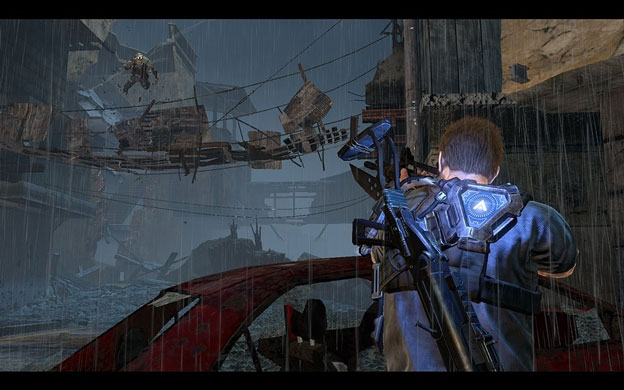
Inversion’s gravity control works in several ways. The Gravlink can create zones of low gravity, which can float opponents out from behind cover, making them easy targets. It can also create high gravity blasts, which can be used to cause objects to crash down into enemies, or simply flatten enemies on their backs. Finally, the Gravlink can be used to pick up and toss objects around, which is useful for damaging enemies and environmental objects
Gravity isn’t always in our heroes’ control, however. Their alien enemies have some control over gravity as well, and can come at the heroes from the walls and ceilings. Players will need to find cover that protects them from enemies on multiple planes, and use gravity wells that shoot the player onto those different planes. Fighting on the walls and ceilings looks fun from the videos we’ve seen, and should be an entertaining change from the overly-grounded gameplay usually seen in these kinds of games.
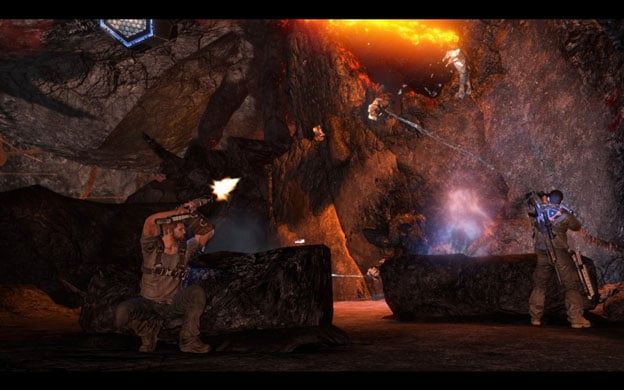
Apart from the gravity-manipulation hook, Inversion treads a lot of familiar ground. Russel and Delgado are typical short-haired, muscular, tough-talking shooter protagonists. Alien invasions are nothing new, and the game’s presentation is very reminiscent of Gears of War. The environments are very destructible, which is always a fun feature, especially when considering the addition of gravity manipulation, allowing the player to do things like pick up cars and fling them at enemies. There’s some worry about Inversion’s gunplay and movement from those who have demoed it, with the weapons feeling lightweight and movement being somewhat clunky. We’ll see if those issues are patched up before release.
The main campaign can be played in two-player co-op, and there’s a standalone co-op mode that allows up to four players. This four-player co-op involves traversing from one end of a level to the other, fighting off waves upon waves of enemies along the way. The aliens in the co-op mode will make use of cover, just as they do in the main game, so players will need to cooperate in order to avoid being overwhelmed. At the end of the level, players must take on a boss creature together.
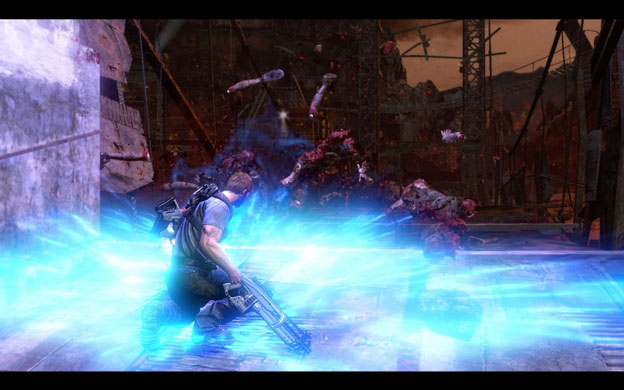
Along with the campaign and co-op mode, Inversion has several competitive multiplayer modes. The Gravlink has potential for a lot of multiplayer fun here, with players able to play fun tricks on each other and use gravity to get the upper hand. We’ve seen a few of the multiplayer levels so far. One, called Hourglass, has players battling over a single control point. One team has high gravity powers, and the other has low gravity powers. Whenever a new team takes over the control point, the level flips over (hence the Hourglass name). There are also deathmatch and team deathmatch modes, where players have to watch out not only for enemy gunfire, but for Gravlink shots that can launch them into the air or pin them down.
With an otherwise rather generic design, Inversion will live or die based on its gravity-twisting gameplay. Will that feature attract gamers and allow the game to develop a long-term multiplayer community, or will it be a flash in the pan? It all depends on how good the gameplay feels, and whether Inversions’s developers are able to patch up the issues with guns and movement that have irked preview players. We’ll have a final verdict around February 7, when Inversion comes out in North America.
Game Features:
Oh, the Things We Do with Gravity…
It seems that cover-based combat systems are becoming the norm for third-person shooters these days. Inversion is a game that takes this idea and flips it on its head—literally. This shooter is all about messing with the idea of gravity, and you’ll often see people walking upside-down on ceilings. I gave Inversion some play time at E3 this year, testing out both single-player and multiplayer modes. So is this gravity gimmick enough to make Inversion stand out among the pack? Let’s find out.
If you’ve ever played a cover-based third-person shooter, Inversion should feel fairly familiar. You can run, duck for cover behind waist-high objects, and switch into a down-the-barrel view for shooting. However, once you start playing the campaign, you’ll realize early on that you are getting shot at from a direction you didn’t expect—above you.
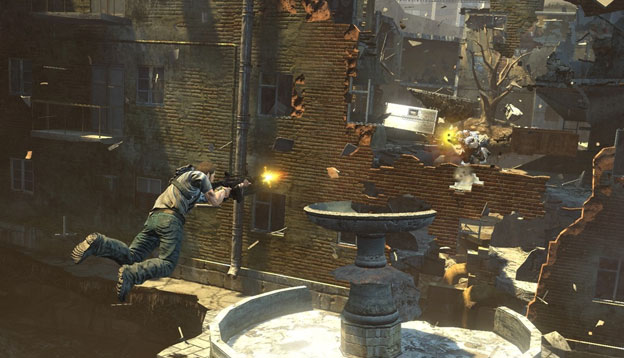
Inversion manipulates gravity to create a faster-paced action environment. The game is cover-based, but cover doesn’t help you very much when the enemy is standing upside-down directly above your head. The game maps use the idea of vectors, areas where gravity changes direction. For example, you can see people running on the walls and ceilings. It’s almost like Super Mario Galaxy meets Gears of War. What’s really fun is getting ready to toss a grenade and seeing its trajectory as a wave shape instead of the more familiar arc shape.
To make things even more interesting, you have a Gravlink gun that lets you shoot a sphere of energy to negate gravity in a specific area. Anything in this sphere will become temporarily weightless and will just float there in midair. Yes, this includes enemies behind cover. You can mess up gravity around people that are hiding from you so that they float out of cover and into a more vulnerable position. I even tested this mechanic by shooting it into a pool of molten lava that was off in the distance. A sphere of molten lava floated weightlessly upward. Nice.
The Gravlink gun also works a lot like the gravity gun from Half-Life 2. You can pick up impossibly heavy objects and throw them with great force. You can even pick up enemies and perform brutal body slams, smashing them into a wall or floor. In fact, I was told you can get through the entire playable demo without using any weapons besides the Gravlink gun.
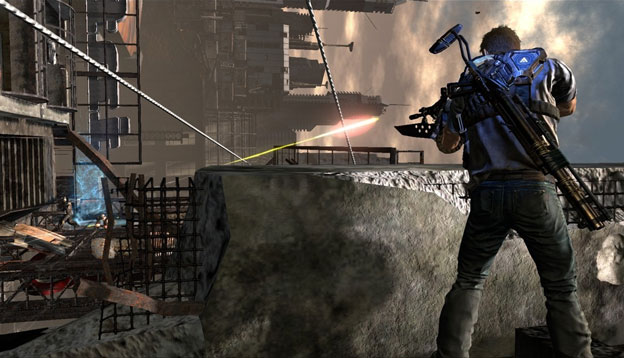
In the single-player campaign, I faced off against hordes of mutants in an area with a lot of boulders and lava. They were unarmed, but tended to move fast and in packs. I realized it was much easier to toss boulders at them than to shoot them, due to their large numbers. Otherwise I could send a massive gravity-reducing blast their way to slow them down and pick them off one at a time.
Multiplayer modes like deathmatch are where I think this game shows the most potential. I learned all sorts of tricks to dispose of other players, like tossing a grenade at an opponent behind cover then throwing a zero gravity sphere to leave the player helplessly hovering near the live grenade. Another technique is to toss a sphere to make boulders hover in front of you, giving you some protection. However, this has to be used with caution, because quick-thinking opponents can hurl these boulders back at you.
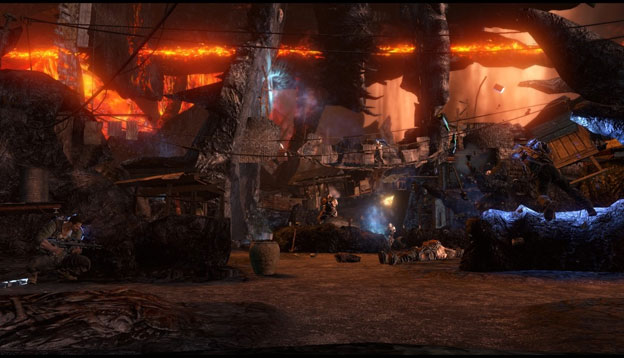
But this gravity mechanic doesn’t ever leave players completely helpless. Even when you are hovering, you can still use your weapons. Players with fast trigger fingers will be able to bring down opponents even when they are floating in a zero gravity zone.
In the map I played, there were green glowing circles on the ground. These were zero gravity areas that could be used to launch players into the air. I didn’t spend enough time with the game to get these sorts of jumps perfected, but I saw some other players do some pretty wild things using these zero gravity zones.
In my brief time with inversion, I got to see a bit of the strategies available to players. However, the developers are anticipating players will find unique ways to play that they never even thought of. This gravity mechanic has a lot of potential for improvisational gameplay, and we’ll have to wait to see what the online community will come up with.
Inversion is scheduled to launch for both PS3 and Xbox 360 on February 7, 2012, and a PC release is in the works for a later date.
Game Features:
